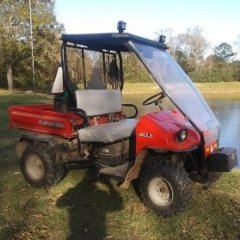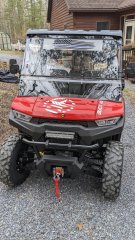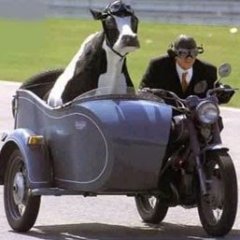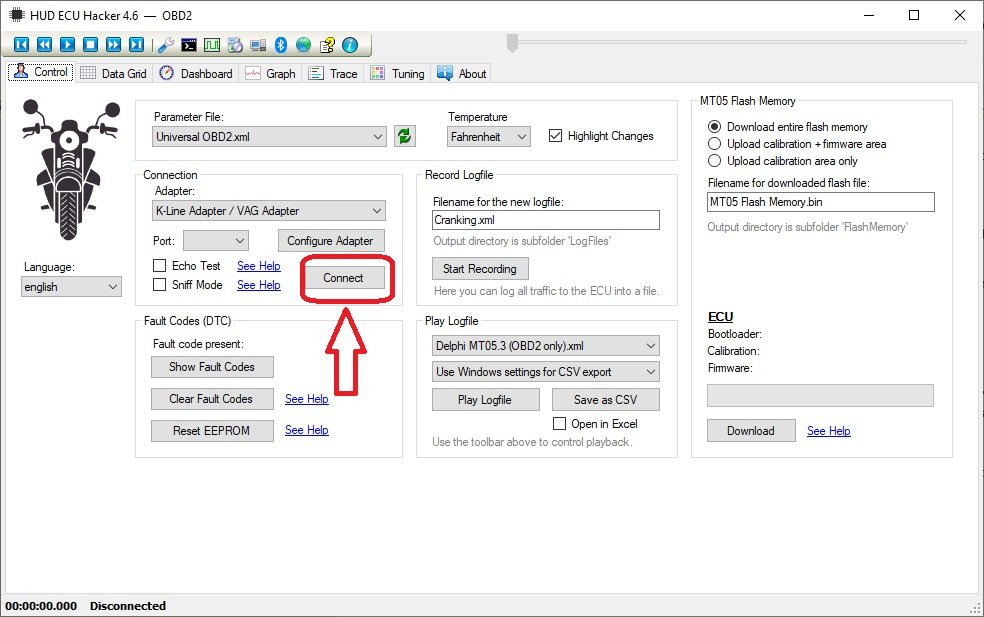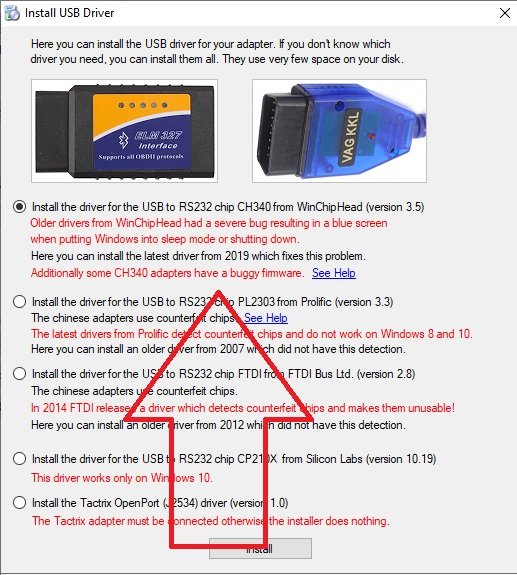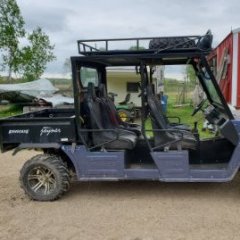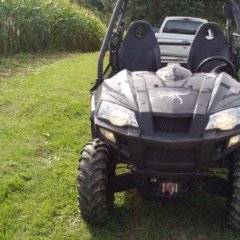Leaderboard
Popular Content
Showing content with the highest reputation since 04/25/2023 in Posts
-
Since I've seen some questions on this I took some pictures and will provide instructions on a valve adjustment for the UT400. This should be the same for the 550's and other various Coleman/Hisun single cylinder models with the cylinder slanted aft. I have seen several people ask of it is really necessary, and read several reports of valves being out of adjustment from the factory. My valves were .004" intake, and .010" exhaust with about 5 hrs on the machine. I've seen different numbers thrown around for factory spec, but I decided to go with 0.005". This is called valve lash. What is is is a gap between the rocker arm and the valve then the camshaft isnt opening the valve. Why does it matter? If it's too large the valve doesn't open all the way, if it's too small the valve dosent close. This can cause valve damage (overheating) as well as loss of engine power (burned fuel is going out exhaust rather than pushing the piston dow). Tools required : 5MM Allen wrench, 10MM box wrench, needle nose pliers, flat feeler gauge set, rags First you need to remove the fan cover on the passenger side. There is a cooling vent hose on the back side, remove the hose clamp and slide it off. From there there are 4x 10mm bolts holding the cover. The forward ones can be accessed from under the seat. Next remove the spark plug from the drivers side. Carefully wiggle the spark plug wire off. Grip it as low as possible and give it a little twisting motion as you pull it off to help free it. Its a tight fit for a socket, but there is a sheet metal wrench in the toolkit that fits it. Unscrew the plug and set it aside. This allows you to spin the motor over freely with no compression to fight. When you reassemble this is a good opportunity to switch to an NGK iridium plug for better performance/less fouling DR8EIX) Next you need to remove the intake and exhaust valve covers. The intake us the forward one. There are 3x 5MM Allen screws to remove. The Exhaust is the rear with 2x 5MM Allen bolts. Both covers have O-Rings instead of gaskets and are reusable. When you remove the rear be careful and use your rags as there will be oil that drips out. Next up we need to spin the motor over to top dead center. Grab each rocker arm and give em a little wiggle up and down. Spin the engine over by grabbing the fan with your other hand. Spin the engine over until both rockers have some wiggle and are loose. Once both rockers are loose slide the feeler gauge in like shown above. Try different feelers as needed to determine your starting spec. You should feel some drag but still be able to move the feeler without too much force. If you need to adjust, use the 10MM wrench to slightly loosen the locknut, then with the correct feeler gauge in place, tighten the top square nut while wiggling the feeler in and out. Once you have it right you need to tighten the 10mm lock nut without moving the square head bolt. Once the lock nut is tight recheck the clearance. That's it, button everything back up and make sure you have it all reassembled before running it again. If you find this helpful give me a thumbs up or comment. If you have any questions or need more help let me know. If there's interest maybe I'll do some more of these4 points
-
Hello to anyone who reads this. I am Jon and I own J&M Outdoor Power, a very small, small engine repair shop. I was approached by Coleman about 6 months ago to become one of their Warranty Centers. I recently received 3 different UT400's and a UT500 all with similar issues. These units range from 2 months to 2 years old. Customers state that the unit(s) was/were running fine, then heard a pop and a loss of power, two would no longer start. The two that would run would not achieve normal operating speed (around 20mph I would say) without redlining the RPMs. I quickly found that the Valve lash on each unit had become too large on some(both intake and exhaust) and too tight on one(just intake). After setting the gaps to .005(I found multiple different people suggesting bigger and smaller gaps, but no definitive Coleman Spec number yet) every unit starts, runs, and achieves top speed without issue. I don't know how many others have come across these issues, and I wanted to get something out on the web for others in the same predicament. Please let me know if you have had similar issues. Edit: I realize that this will not be a fix all solution for this issue, as the oil level and condition should be verified before moving to the valves. Many times improper oil conditions will cause valve lash to change. These units all have good oil and proper oil changes.3 points
-
2 points
-
Are you talking about an electric heater? if yes its likely too much current. There might be 10 amps of available current coming out of the rectifier that isn't already claimed by the ECU and factory lights. 10 amps @ 12V = 120 Watts, which is about what an electric heating pad runs. If you're talking about a fan for a engine coolant based heater it's probably ok. If you have accessories and the running voltage is below 13.5V you have too much stuff attached. If the battery light comes on it means the battery is actively being discharged while running. Stator based charging systems on these things and tractors etc are really meant to power the ECU and factory systems not to provide a lot of extra power for other stuff, it's not like the alternator on a car.2 points
-
2 points
-
The main trick is tilting the front end up. Block the rear wheels and jack up the front end at least a foot. A convenient ditch works well also.....rear wheels in a shallow ditch. The head bleeder screw should be opened. With the engine NOT running, almost fill the radiator (leave some air to avoid a mess) and burp (squeeze the lower hose line before the metal tube at the engine base passenger side floor area). Watch the radiator and the the bleeder. With the radiator "higher" than the head bleeder, the air should be bled and coolant dribble out. Close the bleeder and refill radiator (your clue you displaced the air with coolant) and start the engine. Burp more while running and if you get the circulation going the hoses will warm up. More bubbles should surface at the radiator filler neck. Shut off engine. Open bleeder and release any air in the head. The puke jug needs to be filled about an inch above the full cold line. Use a shop towel as a "seal"and use an air nozzle to SLIGHTLY pressurize the puke tank removing the air from the tubing line to the radiator neck. Then the radiator starts to overflow, a third hand can install the radiator cap. Run the engine and determine the head and hoses are at the close to the same temperature (as in warming up) through out the system. IR temp gun....fairly cheap now....can get real numbers. Scan the radiator, hoses, cylinder and head.....if all close you are done. Recheck fluids when done riding. Recheck the bleeder and top off the puke jug as required.2 points
-
From the look of the picture on the post, I can think of a couple things2 points
-
Its' not a car, this is a motorcycle engine with a small stator charging system. You can't expect to run high wattage accessories like a heater or huge light bars on these things . That will overwhelm the charging system, drain your battery an stop your engine. Could damage the charging system and voltage regulator too. You only have about 10 amps extra to run any accessories including lights.2 points
-
My dealer gave me an electronic version of the service manual and I have sent it to Kingfish. I will see if it will upload here for others to use. I'm not sure if there is a more appropriate way to do this, let me know if there is.. 2015-2017 Service Manual - Sector E1.pdf2 points
-
my Hisun in my Massimo , sold by Tractor Supply, assembled in Dallas, say Made In China on every part of all of it .. Altho it now has multiple Yamaha parts mixed in. lol2 points
-
https://motorcycledoctor.com/wp-content/uploads/2021/08/Valve-Adjustment-HiSun-2.pdf This should do it.2 points
-
Yeah, I adjusted mine multiple times without any luck. I had extended the shifter rod, as mentioned on this board, as well as some videos I watched, and that resolved the shifting issue. Now, after it slips into forward or Reverse, it never slips out. PS: If you go this route, remember to readjust the cable to compensate for the extended shifter. I had to do the adjustment an couple times after extending the shifter and then the problem was resolved.2 points
-
I finally found a service manual in stock and was able to make the adjustments per the specs!2 points
-
Problem was using cheap eBay injector. Bought quality one and hot pipes went away. Running like new.2 points
-
2 points
-
Massimo MSU500 won't shift to low I would check the shift linkage. Adjust it make it a little longer, if it is not long enough it won't shift to low2 points
-
Hello again! I now have a pretty good running Coleman UT400 after a top end rebuild, wet clutch rebuild and a repaired crankcase... ! It plows snow great, but I was also having the jumping out of gear problem, mainly reverse, but a couple times out of forward. I would quickly place it in N and then let the engine idle down and shift again. This worked most of the time. I did some research and found that some have modified the shift linkage. The problem with just adjusting the shift cable is that it really NEEDS more throw, not an adjustment. From what I've read and viewed on the Internet, the linkage arm needs to be about 3/4" longer to gain more throw in both directions. On YouTube, the guy had to remove the shift linkage hole trim and notch the side of the dash to get the shift linkage off the pivot pin. BUT this is NOT necessary. When the "E" clip has been removed and you fish it out of the firewall somewhere, the shift lever is now loose. I had to pop the top of the shift knob off, remove the retaining screw and then heat the lower portion of the knob to get it to come off the lever. Once you have the shift lever loose, push it towards the right to slide it off the pivot shaft. But it won't come off just yet. Use a small pry bar/screw driver and slide the nylon flanged bushing out of the left side of the lever. This lets the lever slide off and get into a "loose" condition and it will twist and come right off without removing the dash trim, that could be a bugger to get back on correctly. Once the lever is off, press out the other bushing so when you're welding on the linkage arm, you don't melt the bushing. I found a piece of scrap metal the same thickness as the lever arm, just over 1/8" thick, close to 3/16". I cut my arm and beveled the edges for better welding. I added a piece just over 5/8" long and kept about a 1/16" gap between the arm and the new piece. Once welded on bother ends, it adds up to just about 3/4" or so. I reinstalled the lever after painting it and did an adjustment on the cable. By the way, it's easier to remove the cable from the bracket on the frame. This gives you more clearance to maneuver in that area with your hands. ALSO, you will need to get a 12" adjustable wrench and slide it over the cable mounting bracket and tweak, to the front, the steel so the cable is pointed upward a bit to now realign with the new longer shift arm lever. There's more than enough metal for the tweak and it will line up perfectly. I now bottom out the shifter on the transmission BEFORE I run out of throw on the shifter... I've tested it just a bit so far and it shifts much better with the longer throw. One of the Coleman authorized repair facilities said that he worked with Coleman to get a new part that's longer by 3/4". He's modified a few and it works perfectly for him. Just doing the cable will just short you on the other end. Here's some pictures of my modified shift lever etc.2 points
-
In order to connect with the ECU we need two cables. The first is a USB ODBII cable. HUD ECU Hacker’s documentation has a lot of different confusing options, but here’s what I went with and managed to get working, the cable is called “VAG KKL” it is a USB to ODB2 cable. It is available from a variety of sources for $10-15. The second thing we need is a “6 pin delphi to ODB2” adapter cable. It is also available for a similar price. In my case I ordered both from ebay, but there are other sources. Once we have our cable in hand we need to find the plug it in on your machine. My personal rig is a Coleman UT400, but the wire location should be similar for all Hisuns. My cable was located under the middle of the seat area. Just inboard of the battery, where the main wire harness split loom runs. The cable is a 6 pin (3x2) with a dust cap. Remove the dust cap and plug in the 6-pin end of the Delphi adapter cable. Note: When I was done, I left the 6-pin adapter connected, and zip tied it so it now runs to in front of the battery for easier access in the future. Next download and install HUD ECU HACKER DOWNLOAD Open HUD ECU Hacker on your PC It should prompt you to choose a driver to install. This particular cable uses the “CH340” driver (First choice on the menu) click to install, once installed hit the X in the corner to go back to the main page Once the driver is installed plug in the USB Cable, and plug the ODB2 end into the 6 pin adapter. The red led on the adapter should light up indicating it has power. Drop down and pick a com port on the main screen, it should show the VAG KKL adapter as a com port. Click connect on the main menu. It will pop up a bunch of fast scrolling text indicating it is connecting. Once connected you can click through the various tabs to see different data sets. The main menu also has the option to show fault codes, clear fault codes, reset the EPROM back to factory. The other function that may be helpful is recording a log file. You can record a log while operating the unit, and come back later and replay it to try to better diagnose what is happening. Within the various pages you will see the reading from each sensor. Sometimes a sensor reading will be off enough to cause running issues, but not enough for the ECU to realize its an issue. For example if the engine thinks it’s really warm, but its actually cold, it may not inject enough fuel to start. There are also more advanced functions, like adjusting fuel mapping, but that is beyond the scope of this tutorial. Full HUD ECU Hacker Documentation (Very technical reading) If you find this helpful give me a comment below or a thumbs up.2 points
-
While I can fully understand Joe B's unhappy experience and his recommendation to go elsewhere, I believe that his unit is/was a HiSun. Those units have been shown to be very suspect, and Massimo was way undercapitalized to support the dealer network and their customers. On the other hand, my 2020 T-Boss 500-F (with the steel box w/dropdown sides) is a Linhai chassis. Except for a few design quibbles (front hood access, oil change mess, inadequate hitch mount and excessive reach with the steel box, overly bright display at night, etc), I have found that the Linhai version to be a solid, reliable, entry-level SXS. I've had the steering wheel loosen up (6 Phillips head screws) and the windscreen brackets needed realignment. I also replaced the 300 CCA U1 Lead acid battery that was OEM, with a 350 CCA AGM U1 battery. That solved the occasional cold start stall and kick back against the starter. The OEM flooded lead acid battery is just too small. Works OK in my lawnmower, though. 😒 I use mine for general banging around my land that has somewhat rough terrain, and I am also equipping as a fast-response vehicle to fight remote wildland fires. Bottom line is that I wouldn't ever consider buying a used 2019 or earlier Massimo or any other brand that uses the HiSun chassis of any vintage. 🏁1 point
-
DON'T BUY A MASSIMO! The quality is soooo bad! I have a 2021 550 TBoss new when inventory of the decent brands was at rock bottom. I paid new what used decent brands were selling for. I quickly learned why. The quality is soooo bad. Out of the gate I had to make numerous adjustments to get it to run, drive and operate smoothly. Couldn't tow anything because the hitch receiver snapped off, the cheap plastic guards in front of the suspension parts broke off in no time, flooring cracked after a bit of use, windshield is now un clear and unusable after cleaning a couple of times (yes, I was extremely gentle), And all of the above and more on a machine I barely use (very low miles) I would love to sell it and buy a good one some day but I don't think anyone would buy it. Listen to all of the advice above and stay away from this brand!1 point
-
Normally yes it touches coolant and you'll need to drain below that level and refill after replacement. When you refill the radiator, these things can be a bear to bleed all the air from the cooling system. Any air left will lead to more overheating issues. There's a plug on the right side of the engine where the rad hose goes in that you can partially loosen while running to help bleed air.1 point
-
Try playing with the adjustment. The 500/550's don't have the same shifter cable/lever issues as the 40's but the cable can stretch over time. If you're getting grinding and popping out of gear it could be worn clutch dogs too, which require some effort to replace as they're internal to the transmission. If you're having shift issues and grinding it's best to be proactive about adjusting because it does damage the dogs over time, and eventually will just pop out of gear at will once the dogs are rounded enough.1 point
-
Hello! I am a University of Notre Dame student and have been enlisted by Lippert Components INC. to help them understand you, Side-by-side users. Taking the survey in the link below would help us to help you in improving the buying experience of Side-by-sides. Thank you so much for your attention and participation. https://nd.qualtrics.com/jfe/form/SV_aYrwsZyjs2ZHK3I1 point
-
I have a 3500LB Winch that only runs in one direction. Inward but not Out. Replaced the solenoid module. Makes "click" when I push the "Out" button and the motor tries to spool out but then stops and begins to "click". Does anyone have suggestions what I should try next?1 point
-
1 point
-
I realize that many of you do not have diesel machines. For those that do, this is for you: Just wanted to post my experience this past week. Here in Texas, we had pretty good dip in temps. For 4 days it did not get above 25. At night, it was single digits or close to it. I always put Sta-Bil fuel stabilizer in the storage tank (30 gallon). And up until this tank I was using Power Service (white bottle) for anti-gel. Never had an issue. This tank, however, I switched to Stabil All season (anti gel). It is supposed to good down to -40. Zap. That is a big fat lie. I put in twice the amount called for in the instructions. Result was less than optimal. I drove the SxS 100 feet (to go get the mail) and it died. I looked at the fuel bowl and it was a cloudy, wax substance. So, the Stabil did not work. That said, I'm not sure that I ever tested the Power Service in the same manner. So I am not saying that one is better than the other. What are your experiences? Are these products inferior? What do you folks in the northern states / Canada use? Am I missing something? CC1 point
-
Hey Folks There are not a lot of good sources out there for troubleshooting and diagnosing ECU problems with the Massimo Buck, Bennche Bighorn, Bennche Cowboy, & Cazador machines that use the Delphi MT05 ECU. They are all basically the same with different badging, so I thought I'd share some info that I found during some searches. I was trying to help someone diagnose and repair a hard starting issue. The ignition coil was throwing a 0351 code. I discovered how to read codes without an OBDII code reader. The following procedures should help you check your fault codes and clear them if needed. Fault Code Troubleshooting for Delphi MT05 ECU on the Massimo Buck 400, Bennche Bighorn 400, Bennche Cowboy 400, and Cazador 400 *NOTE: The MT05 ECU is not really OBD 2 compliant. It is much more similar to an OBDI system. The MT05 ECU controls either 1 or 2 cylinder engines commonly found on Massimo, Bennche, and Cazador. Much of the ECU info was found here: https://netcult.ch/elmue/HUD ECU Hacker/Delphi MT05 Manual.pdf Delphi EFI System Design Delphi EFI employs 5 sensors to monitor engine performance. 1. Crankshaft Position Sensor 2. Coolant Temperature Sensor 3. Oxygen Sensor 4. Throttle Position Sensor 5. Manifold Air Pressure/Manifold Air Temperature (MAP/MAT) Sensor Delphi EFI employs the following system components. 1. MT05 Engine Control Unit (ECU) 2. Fuel Pump 3. Multec 3.5 Fuel Injector 4. Idle Speed Control Valve (Idle Stepper Motor) 5. Multec Ignition Coil 6. Fuel Vapor Canister Purge Valve Using the Digital Dashboard to Decipher EFI Trouble Codes In addition to commercially available diagnostic scan tools (Big $$$), you can use the engine warning light of the Siemens dashboard to diagnose most of your EFI problems. The digital dashboard receives signals from the MT05 ECU, and the engine warning light will flash a diagnostic trouble code (DTC) if the ignition key is switched on/off for three cycles. When you turn on the ignition, the engine warning light will illuminate, which indicates the EFI system is operational. After the engine is started, the engine warning light will extinguish if the EFI system is working properly. However, if the engine warning light remains illuminated, it indicates the EFI system is not working properly, and there is a system component failure. Deciphering Diagnostic Trouble Codes To read the diagnostic trouble code (DTC), open and close the ignition key three times in rapid succession, as follows: open/close—open/close—open. At this point the engine warning light will flash a DTC which indicates the fault in the EFI system. Refer to the attached fault code table to identify the corresponding problem. The engine warning light will emit a sequence of flashing lights. If the light flashes 10 times, the translated number is 0. If the light flashes one time, the translated number is 1, et cetera. For example, if the MAP/MAT sensor is disconnected, or the connector is shorted to ground, the engine warning light will flash in the following manner (This is an example only). The engine warning light will flash 10 times: The first number of the DTC is 0 After an interval of 1.2 seconds, the engine warning light will flash 1 time: The second number of the DTC is 1 After an interval of 1.2 seconds, the engine warning light will flash 10 times: The third number of the DTC is 0 After an interval of 1.2 seconds, the engine warning light will flash 7 times: The fourth number of the DTC is 7 The resulting DTC is P0107. NOTE: For the system I was helping to troubleshoot, I suspected an ignition coil failure due to the code that was thrown. When it was checked, it was flashing: 10, 3, 5, 1. The 10 represents a 0. So the actual code was 0351. After finding the code, the coil wire was checked and discovered loose at the spark plug. Once it was pushed fully on, the problem was fixed. Most likely, this problem was created after the owner had pulled the spark plug to check the gap. The ECU was rebooted using the procedures detailed below with no more codes being thrown. If there are other fault codes, the engine warning light will flash the next code in 3.2 seconds after finishing the first sequence. After all existing fault codes are flashed, the engine warning light will repeat the fault codes in a loop sequence, until the ignition key is turned off. To clear fault codes you either need an OBDII Fault Code reader and a Delphi 6 pin connector adapter cable that you have to order from China and wait 8 weeks…OR....you can simply reboot the ECU using the instructions detailed below. Rebooting the ECU Perform the following steps to reboot the ECU. 1. Turn off the ignition for 15 seconds. 2. Turn the ignition on/off for 5 cycles. Make sure each cycle lasts about ½ second, verifying the start of the fuel pump for each cycle. If the fuel pump doesn't start during any cycle, begin the entire reboot procedure from the beginning. 3. Turn off the ignition for 15 seconds. TPS (throttle position sensor) re-learn procedure after rebooting ECU. This should be done after replacing the TPS or the ECU....and it is advisable to check proper idle after rebooting an ECU too. Source: ECU Hacker (Reworded process slightly to make it a more sensible flow in my mind): 1. Turn the idle screw one full turn clockwise before starting 2. Start the engine, and run at low idle until the engine warms. Maybe a couple of mins. 3. Idle should be above 1500 rpm. If it isn’t, turn it up to 1700 then shut the engine off. Do another reboot of ECU. 4. Restart the engine and let it stabilize at 1700 rpm. Then turn the idle screen down to 1500 rpm and let it stabilize for a few seconds. Once it stabilizes, set to the final recommended idle speed for your machine. The placard under (or behind) your seat should show idle speed, valve adjustment, spark gap, etc. Typically the 390 cc engines in the "400" machines run at 1600 rpm idle. 5. Shut it down. Wait 10-15 seconds before restarting. The procedure is now complete. Final Notes: I have included pictures of an OBDII connector and the Delphi 6 pin connector in case anyone wants to go buy stuff off ebay or local parts suppliers and build a connector to use for an OBDII reader. But...you can save money and simply do the same thing with code reading and resetting using the check engine light on your dash. Some folks prefer to do it with code readers. Hope the information provided helps if anyone ever needs it but cannot find it in repair manuals. I discovered most of this in some motorcycle forums. The source for the diagrams is here: https://netcult.ch/elmue/HUD ECU Hacker/ Be advised: I am not a service technician. I do not endorse any manufacturers. I do not get paid to help, nor do I want to. This is just a hobby of mine. I enjoy working on things and solving problems. If you run into a weird problem that stumps you, give me a shout. I may be able to give you some ideas...or not. Just know, that troubleshooting thru emails can be challenging. The more info you can provide, the better. Otherwise, I will probably ask you a ton of questions. The good news is, the Delphi system used on these machines is essentially an OBDI and it is very simplistic. If you are methodical and patient, most of your "problems" can be figured out thru a process of elimination. Always go for the simple things first before throwing money and sensors at a machine. Take care - JT1 point
-
It was a couple months ago and looking over my previous post, I'm not sure exactly what I did or if it was actually .8mm. Doesn't seem that is what I would have done, but instead I would have adjusted the gap somewhere in between the .6mm and .7mm. Sorry I can't remember exactly, but I can say that the plug, inside the tailpipe, as well as the OS2 sensor, were all carbon covered. In my case, the starting issue I was having and the carbon buildup was due to water in the gas tank. According to my mechanic, he stated that there was enough water in the tank to cause my starting issue, as well as the cause of carbon buildup on the plug, OS2 sensor and tailpipe. After being repaired, so far, my UTV is starting and running great since the water was removed and the tank filled with fresh gas. I haven't checked the plug or sensor as of yet to see if carbon has reappeared, since the UTV was repaired and now running good. Are you having other issues, such as hard starts, stalling etc.,?1 point
-
If your model is fuel injected then look at the AIC valve/servo motor that is located under the throttle body. My 2021 Hisun i.e. Axis 700 periodically does the same thing and the cause is the AIC sticking. The AIC has a small mushroom shaped piston that is internal threaded that opens and closes based on the input to the ECU. The symptom's you described are exactly what I have when it sticks. It did it again to me this last week. The fix for me is to remove it very carefully as it has some small part that can get lost rather easily and clean the carbon off the piston. This time I think I'm going to add a little grease to see if it stops sticking. I might even polish it up gently with buffing compound using a Dremel. I actually loosen the throttle body and turn it to get access to the thing.1 point
-
1 point
-
Look at the "Man Hole" threads and you will find a cut into the threads, line this up to the flywheel timing marks and that will be your TDC.1 point
-
Unless chain is stretched badly they sould essentially be bang on, even with stretch and marks not perfect, one tooth off is quite obvious. Also be aware some models have a mark on flywheel at F for fire, ignition timing, another at T for TDC make sure you have the right mark or your beating a dead horse. Hope this helps1 point
-
1 point
-
download my manual i uploaded here, will tell you everything you need to know and then some1 point
-
Hi there…one of the few disappointments with my new side by side is the low beam lights. They seem to be little more than driving lights. Is this a common complaint amongst owners? Rufus1 point
-
Would like to let everybody with the 23' Z Force units know that Spring Brake Thingy now has a parking brake available for these units. Pretty easy install, the brake pedal does need to come off for a couple holes to be drilled, but that's not all that difficult. These are all made here in the states, like all of our other models. see it at: http://springbrakethingy.com Mods: if we need to do something as a vendor please let me know, couldn't find any info and don't want to brake any rules......1 point
-
Ryan I don't see where it would be any different than any other engine. Ask Redbeard. Google him on youtube. I know he runs some and he likes to remove the governor.1 point
-
So as an update to my UTV having starting problems, it went from three try's to get it started to not starting at all. Before approaching any valve adjustment, I decided to check the spark plug, as I was now smelling some flooding. At first, while I was trying to fit the right socket size to remove the plug, I noticed it started getting wet around the plug. Gas seemed to be leaking out around the plug. When I removed the plug, it turned way too easy, which was telling me it wasn't installed properly and may have been too loose. When removed, it showed signs of flooding, probably from trying to start it so many times. The plug also had carbon buildup and the gap was too small. (Note: the manual I have states in one spot that the gap should be 0.8mm, then elsewhere it states between 0.6-0.7mm. So which is it?) I installed a new plug setting the gap to 0.8mm and on the second try, it fired right up. I let it sit for a short period of time and the same thing, it took two try's but started right up every time thereafter. We shall see what happens today and at a later date, recheck the plug. I know that the gas that came with it had been a problem, as it was sold to me new, but I know it was used (long story). It is a 2019 and I just purchased it about 3 months ago. Tractor Supply stated they added some gas and fuel treatment to help with any water that may be in the tank. Although I added plenty of non-ethanol gas and when the tank was down to 3/4 I added more plus some Seafoam, but that's when things got worse. So now I'll probably let it sit and run to use up the gas so I can start with a good tank. Then I'll change the fuel filter and hopefully not have to go as far as a valve adjustment. We shall see and hopefully it was just bad gas causing carbon buildup. I will update as I go along.1 point
-
yes I can hear it clearly.. sounds like a knock to me. With Massimo it could literally be anything.1 point
-
Rainman I found out that it was my valves needed to be adjusted so I adjusted them to the specs which was.005 and I will fire up perfectly like new hopefully this can help you1 point
-
I'll start by saying i'm learning as i go & have come a long way, but there are some maintenance issues on my mule sx that must be addressed & i've got nobody around with experience & cannot bring it to a shop. I've got rolling resistance when i jack up the front wheels. Months ago i thought i was possibly a brake issue but didn't yet have the equip. to pull the wheel hubs or press them back on... but the noise/friction seemed to resolve itself. I just checked up on it because i've got the tools for dealing with the brake system now and i noticed the wheels dont really spin... theres a lot of resistance and i can hear it coming from the front diff. I can't remember if it used to do that before, but i dont think it did. Its not the drive shaft or u-joints, but i've yet to pull them to be certain. it really sounds like its in the front diff. just where the drive shaft connects. Should the front wheels - when in neutral and in 2wd and no diff. lock - spin freely? Theres too much drag for mine to even go once around. Can anyone point me in a direction? Otherwise its trial and error with cv axles, ball joints, brakes, etc. and i dont have the $ or time for that. I'm in over my head and really hoping someone can help. I'll try to make a video of whats happening, hopefully the sound will come through well. Maybe that will help diagnose it. Thanks.1 point
-
Thanks for stopping by. I live out in the country and wanted to get a good Side By Side to get around my land and the local township I live in. I picked up a '23 bobcat UV34XL (Gas), and I hope I don't bug anyone with all the Questions that I will/may have.. I look forward to reading and having conversations with everyone.1 point
-
Yeah with the Yamaha timing components, cam and valves the motor was better and maybe that cratered the trans? So a Yamaha motor will probably gut the axles... Sent from my moto g stylus using Tapatalk1 point
-
Well, it wasn’t either of those, after tracing wires, cleaning every connector and adding dielectric grease, no bad wires and fuse was the first thing I checked/changed. It was the relay, $45 on eBay and it’s now running again, with a much quieter fuel pump to boot!1 point
-
My wife and I made the 1.5hr trip and picked up our new CanAm Defender XT HD9. So far I really like it and I'm happy with our decision. I also got the new front and back windshields from Rad Accessories. I chose the light tint on both. Super easy install as they come assembled just twist and lock. I also installed my SuperATV rear view mirror. I also removed the door nets after I took these pictures. The power steering is great and for a 975cc engine it is very quiet. I still plan to add some of the under seat storage tubs, a LED light bar on the front bumper, maybe one on the top of the windshield and a couple of pod lights on the back of the cab for rear lights.1 point
-
COLEMAN UT 400 NO REVERSE WE FOUND THE CURE! In our case adjustment would make the UT 400 go into reverse but you would loose forward in the doing, very frustrating! However when removing the seat and the upper engine cover you can see the shift lever clearly and with the cable adjusted properly to engage forward and the ever so annoying ratchet sound of reverse gears we found if you apply slight pressure to the shift lever on the transmission it would engage! Turns out there is just simply not enough throw on the cable, So back up to the shift lever and noticed there is a stop next to the detent on the lever that if slightly more gap would allow just a bit more throw. So here is the cure, Remove the nut (10MM) on the cable post, remove the C clip from the pivot post, remove the bezel ring at the shift lever by bending straight the tabs and remove the shift lever. I used a 4 1/2 inch angle grinder with a cut off wheel and removed about 1/2 of the stop on the inside edge next to where the detent ball will sit on both the reverse and forward sides of the lever (cuz lets just be certain) After reassembly it was noted that simply holding the shift lever into the gear you want and ever so gently tapping the throttle the transmission selects both forward and reverse every time without fail. You see the cable is only as long as it is and adjusting it will only make it go one direction further, but by removing a bit of metal it allows the whole thing to travel just enough to make the difference. I'm not going to say this is the end all be all but it sure worked for us and maybe with a bit of luck will for you as well.1 point
-
The P.S. has me thinking......you mention "Fuel mist" out of the valve rocker cover. All you should is basically NOTHING at crank speed. Any vapors blown out are from blow by (past the rings) into the crankcase. IF you are OVER FUELING and wetting down the cylinder walls (that is, washing off the oil coating) you will have blow by. Oil coating helps seal the rings. That is why an engine that has set (dried out) and low compression is given a shot of WD-40 or any light oil to seal the rings. This leads to the next thought.....If over fueling, the raw gas will "drain" into the crankcase and dilute the motor oil. Check motor oil level.....too high?....too thin?.....wipe on tissue and sniff the oil....Gassy smell?....will light off with a burn test (soak up some oil on a paper towel and see how fast it starts to burn). Oil basically won't. Diesel will start slowly but take off. Gassy oil....if you value the hair on body parts...hold at a distance with long needle pliers!!!! Gassy diluted motor oil will add to the fuel/air mixture via the breather tube. Similar to a turbo seal failure on a diesel......RUNAWAY even after the injector pump shut down...very bad ending! Drain oil and replace filter....won't get it all (always some oil remains that cannot drain) but will dilute the gas. BONUS: Pulling the vent tube will clean up a mystery RICH run be it carb or FI (everything is correct BUT) after the motor warms up and cooks off the gasoline----sorta like an EGR Evap system. Slop fuel never lights off or barely runs depending on the degree of "slop". You state pulling the injector, the engine runs until it runs out of fuel. ARE you leaving the injector hole OPEN. This will allow lots of fresh air into the cylinder and will light off a rich mixture and then die because no more fuel is injected. ASSUME the ECM is sending the correct pulse width to the injector for now. Injector can hang and "piss" instead of spray. The key is the 14.7/1 air fuel mixture. Too RICH.....runs heavy and then dies at idle. May start to run, but as the leftover UNburned charge gets richer-----labors-----pukes. Too Lean......no start....fuel is there but cannot lite off.....then as it builds up, you get a pop only to be to lean again.....repeats the cycle.....THIS IS HELL ON THE STARTER AND REDUCTION GEARS. This also load the oil with gasoline (unburned). Again the fuel correct, look for a restriction in the air intake (not enough air).....common causes....CRITTERS...mouse house....full of acorns....rag pulled in for a nest, and so on. EASY TEST: Remove the air intake plumbing at the throttle body. Plenty of air now. If runs, check out the air box/plumbing. IF NO RUN....next section. Too much fuel: Time to test the ECM/injector system. ANY BAD input signal to the ECM will make the fuel delivery too much or too little. Pull spark plug. Read the insulator tip color. Just right is a light TAN color. Very WHITE...blistered LEAN. RICH has a BLACK, SOOTY, shiny black/wet black (carbon is fuel soaked). If really black, they might fire outside to the engine block BUT "blowout" under compression even at idle. If not too bad, they might run at idle but when sputter and die when a heavy demand on the ignition system (acceleration) is applied....drop in a new plug for testing to just to reduce the possible list of problems. Pull the connector to the fuel pump (under the pass seat). This is the fuel pump power (from ECM) and fuel level signal. No guessing if you found the right fuse/relay. This will stop the fuel delivery (40 PSI) to injector. Injector will still get pulses. You will shoot a short burst of starter fluid into the air box (plumbing reattached and filter OK). The motor should lite off and run until it is out of fuel. Repeat. Repeat. If works every time, give a double burst when running to "sustain" the run. Repeat. If this works, you have the ECM/input signals to ponder. This gets deep for most. Coolant temp sensor....open circuit RICH. Thinks it is at the SOUTH POLE -40 C. Like a choke for carb. Throttle position sensor.....wrong fuel mix to match the air thru the butterfly valve. MAP sensor/ambient air temp....measures engine load....wrong signal rich and lean. O2 sensor....signal to tell if RICH or LEAN. Has heater circuit to get it up to operating temp. Heaters open (toaster that does not toast). Throw in smashed wires, critters that live the taste of plastic insulation on wires, stick run thru harness, heater shorted to SHARP edged heat shield above the exhaust. More common failures are the MAP/IAT (intake air parameters) and O2 sensor. You got a lot of checks to get down to where the problem is. BTW, the ECM is a DELPHI MT05 small engine unit capable of a twin (2 inputs for the two cylinders individual O2 sensors). Check out web page for specs, pin outs for both the Grey and Black connector (PDF format)....magnitudes better than the "manual" supplied when first built. Only covers the electrical engine management with a generic diagram of the analog input(s) and the outputs like fuel pump, ign coil, etc CHOW.1 point
-
Joe, everyone on here is well aware of your opinion. Feel free to share useful technical info or answer questions. You have contributed plenty of useful posts over the years, but showing up just to post garbage bashing certain brands isn't useful to the discourse. We are all aware we bought cheaper machines and made compromises in doing so. This forum can be a useful place where we can all come together and share helpful info about these machines.1 point
-
You do realize that virtually every item manufactured in significant quantity is manufactured in China right? And you do realize that Yamaha, Honda, Polaris, Massimo, etc. don't own any of the manufacturing companies in China because China is a communist country so the government essentially owns every business right? So all of these vendors that sell in the US are distributors. They don't make the parts, they may, like Massimo assemble components and subassemblies into finished vehicles in the US, right? You understand that? Now let's look at why this is the case. what do you think the reason is? I'll give it to you. It's not because people don't want to make things in the US, most everyone would prefer that. It's because it more or less IMPOSSIBLE to manufacture anything significant in the USA and not because of labor cost. Labor cost have little impact because most major manufacturing is highly automated, using little human labor. No, the reason is US government regulations and restrictions (and their friends in the legal business) make it cost and legally prohibitive to make metal, plastic, glass, etc. all the basic components of any complex device. No company can survive trying to do major manufacturing in the USA and they can't open a plant in China (which has no labor laws, no EPA, no OSHA, etc. ) because everything in China is government owned. So the only option is partnering with a Chinese company, and so every major US product vendor does that. Honda, Yamaha, Polaris, etc. all the basic parts that need to be made in large quantity are made in China. If you don't like this, then you need to think hard about how you vote and pressure politicians to be more US friendly and less China friendly. That's the real problem. It's not an excuse for Massimo's lack of attention to customers and quality control. They could do better, but these problems are not exclusive to Massimo and it's a symptom of poor US government and huge over-reach in regulations and favors to special interest and outside influences. If the US government and corrupt politicians would clean up their act, companies with poor products and poor customer services couldn't survive, As it currently stands, high quality and good customer service is too expensive and too much legal and regulatory lability to compete in the USA. Sitting back an blaming companies struggling to survive won't fix it and the current US administration is tacking on more and more odious regulations which have crippled the supply chain and manufacturing, so hang on to your wallet, its going to get worse.1 point
-
Against the brute it launch faster than my utv but around 65kph i close the gap and pass in front at around 100kph Against the renegade i stay behind but not by so much distances And against the Polaris on 27" tire it was neck and neck whit my utv until we Reach 30kph and leave it in the dust In deep mud my utv on OEM 25" tire have beated all ecxept the renegade but its okay i was pulled only one time for the entire day One of the 4 brute force got big electrical issue and 2 brake an axle in the marsh For a chinese product all guys as been quite impressed on the overall performance and reliability of it for the price1 point
This leaderboard is set to New York/GMT-04:00


